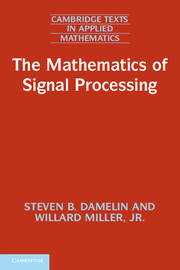Book contents
- Frontmatter
- Contents
- Preface
- Introduction
- 1 Normed vector spaces
- 2 Analytic tools
- 3 Fourier series
- 4 The Fourier transform
- 5 Compressive sampling
- 6 Discrete transforms
- 7 Linear filters
- 8 Windowed Fourier and continuous wavelet transforms. Frames
- 9 Multiresolution analysis
- 10 Discrete wavelet theory
- 11 Biorthogonal filters and wavelets
- 12 Parsimonious representation of data
- References
- Index
Introduction
Published online by Cambridge University Press: 05 June 2012
- Frontmatter
- Contents
- Preface
- Introduction
- 1 Normed vector spaces
- 2 Analytic tools
- 3 Fourier series
- 4 The Fourier transform
- 5 Compressive sampling
- 6 Discrete transforms
- 7 Linear filters
- 8 Windowed Fourier and continuous wavelet transforms. Frames
- 9 Multiresolution analysis
- 10 Discrete wavelet theory
- 11 Biorthogonal filters and wavelets
- 12 Parsimonious representation of data
- References
- Index
Summary
Consider a linear system y = Φx where Φ can be taken as an m × n matrix acting on Euclidean space or more generally, a linear operator on a Hilbert space. We call the vector x a signal or input, Φ the transform–sample matrix–filter and the vector y the sample or output. The problem is to reconstruct x from y, or more generally, to reconstruct an altered version of x from an altered y. For example, we might analyze the signal x in terms of frequency components and various combinations of time and frequency components y. Once we have analyzed the signal we may alter some of the component parts to eliminate undesirable features or to compress the signal for more efficient transmission and storage. Finally, we reconstitute the signal from its component parts.
The three typical steps in this process are:
Analysis. Decompose the signal into basic components. This is called analysis. We will think of the signal space as a vector space and break it up into a sum of subspaces, each of which captures a special feature of a signal.
Processing. Modify some of the basic components of the signal that were obtained through the analysis. This is called processing.
Synthesis. Reconstitute the signal from its (altered) component parts. This is called synthesis. Sometimes, we will want perfect reconstruction. Sometimes only perfect reconstruction with high probability. If we don't alter the component parts, we usually want the synthesized signal to agree exactly with the original signal. […]
- Type
- Chapter
- Information
- The Mathematics of Signal Processing , pp. 1 - 2Publisher: Cambridge University PressPrint publication year: 2011



